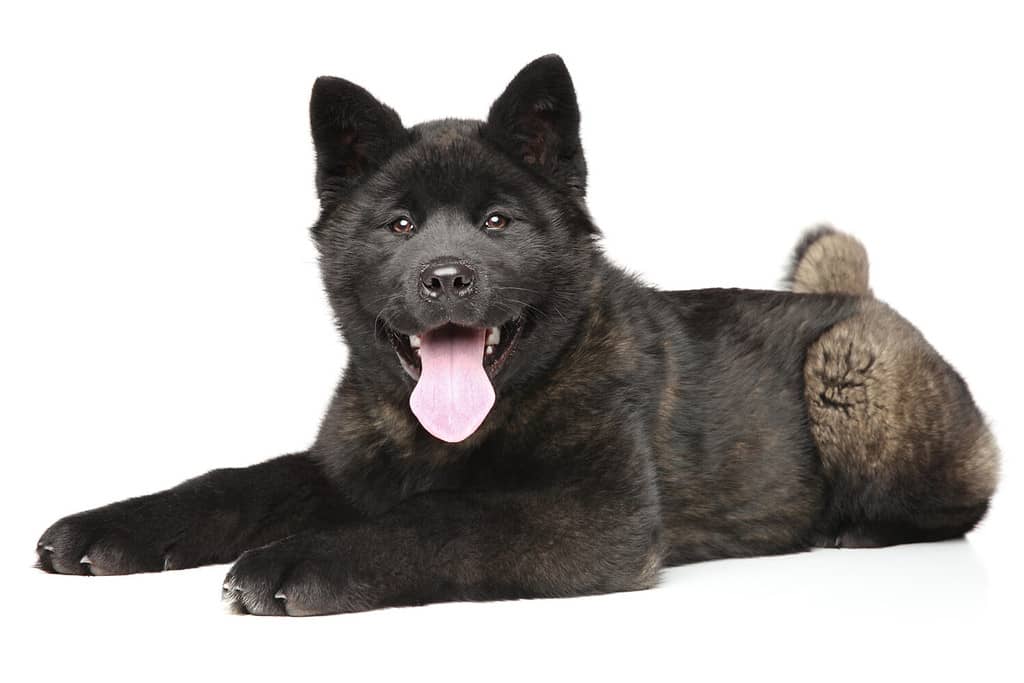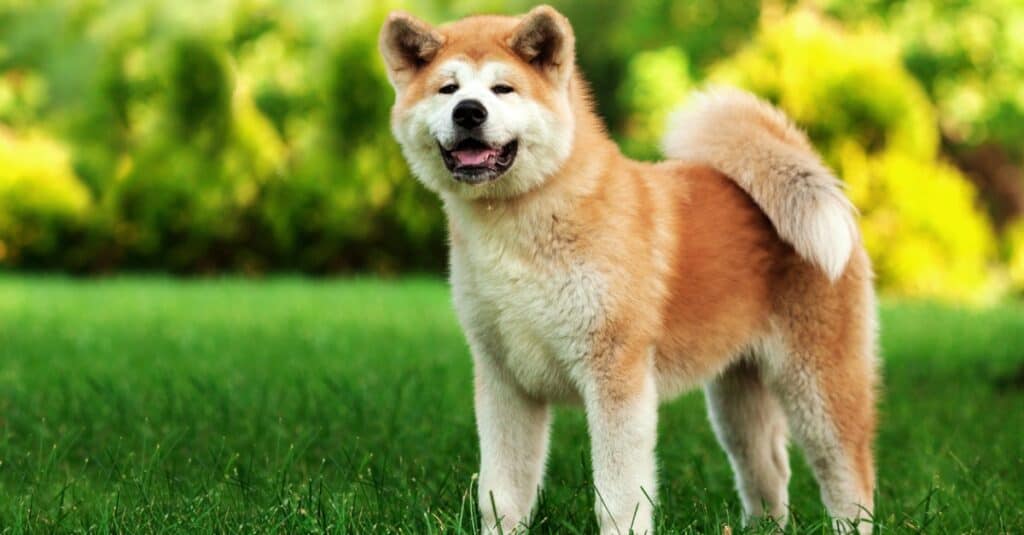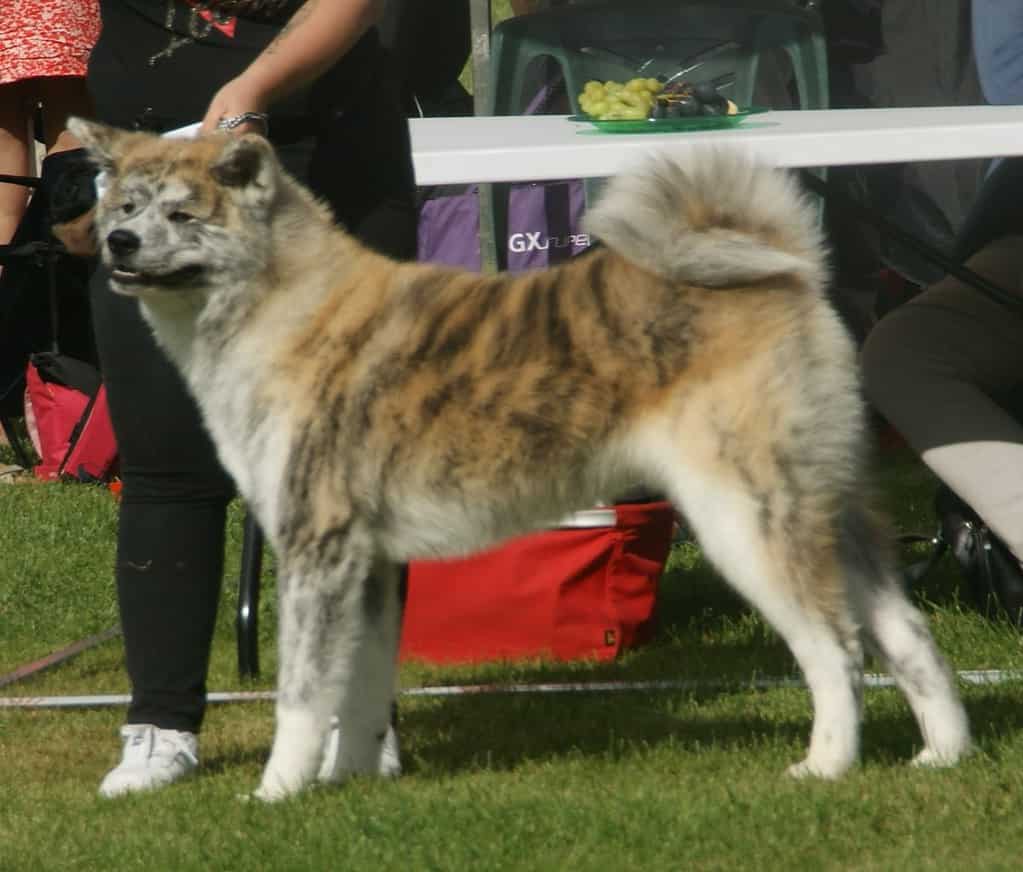Akitas originated from Japan and once belonged exclusively to the royal family, but times have changed! Today, their loyalty, intelligence, and good looks have made them popular worldwide. Symbolizing good health, happiness, and longevity an experienced dog owner best keeps this powerful dog. If you’re thinking about adopting an Akita, you might want to consider male vs. female Akita differences first.
Key Differences Between a Male and Female Akita
| Characteristic | Male | Female |
|---|---|---|
| Size | As early as six months but mature after a year | Clever, stubborn, wary, but playful |
| Weight | 100-130 lbs | 70-100 lbs |
| Reproduction | 24-26 inches at the shoulder | Six months to nine months |
| Health | Prone to joint problems due to size | Prone to joint problems due to size, but less illness-prone overall |
| Temperament | Clever, stubborn, wary but playful | Clever, willing to please, wary, and often aloof |
| Training | Essential. Stubborn nature may interfere | Essential. Easier to train |
Male and female Akitas look almost identical, but there are a few subtle differences in their physical appearance and temperaments.
The key differences are that males grow slightly larger than females; they’re more boisterous and harder to train. Females tend to attach themselves to one family member, but they are usually a touch calmer and more willing to please.
Let’s look in greater depth.
Male vs. Female Akita: Size

Male Akitas are usually a few inches taller than females.
©Kseniia Kolesnikova/Shutterstock.com
Originally bred as a hunting dog in the Japanese mountains, Akitas are large, stocky dogs with powerful limbs. A male’s average height is 26-28 inches at the shoulder, and a female’s clock is a little smaller at 24-26 inches.
However, individual variations can mean a female Akita grows larger than average, and a male could remain smaller.
Male vs. Female Akita: Physical Traits
Both male and female Akitas have large, broad heads, curled tails, and fluffy, dense coats.
We’ve seen that males tend to reach bigger sizes in general. This applies to not only height but also head size, limb length, and general chunkiness. Other than size, their physical traits, including coat color and webbed feet, are the same in both genders.
When it comes to coats, male and female Akitas shed the same amount, but they don’t shed continuously. Instead, Akitas shed a large amount over a few weeks and then stopped. The amount of fur they shed is considerable! Both genders benefit from regular professional grooming and daily brushing with a shedding comb.
Male vs. Female Akita: Weight
Large male Akitas weigh 100 -130 lbs of bone, muscle, and fluff. In contrast, females weigh less, tipping the scales somewhere between 70 -100 lbs.
Most male and female Akitas finish growing between the ages of one and 18 months, but some continue to fill out until the age of three.

Female Akitas weigh between 70 and 100 lbs.
©Jagodka/Shutterstock.com
Male vs. Female Akita: Reproduction
Female Akitas can reproduce by the age of six to nine months, whereas males generally take up to a year to reach sexual maturity. However, this is a general guide. It’s possible that a male Akita could sire puppies from six months.
Neutering is a topic of debate. Most veterinarians agree that neutering too early causes health problems because the Akita (or any breed) needs puberty hormones to complete their physical and temperamental development.
However, not neutering at all can lead to undesirable personality traits, especially in male Akitas. This includes aggression, increased risk-taking and confidence, a strong libido that leads to unwanted mating behaviors, and a desire to roam.
The Akita Club of America suggests waiting 12 months before sterilizing a male or female Akita, but if a pregnancy is likely and unavoidable, neuter females between six to nine months. Sterilizing female Akitas not only avoids unwanted pregnancies but can have a beneficial effect on breast tumors and urinary tract infections.
It is cheaper to neuter a male Akita than a female due to the procedures involved.
Male vs. Female Akita: Health Considerations

Large Akitas are prone to joint problems such as hip dysplasia.
©TatyanaPanova/Shutterstock.com
According to the PDSA, large-breed Akitas are prone to health problems due to their size and purebred status. Be sure to purchase your Akita from a reputable breeder who has screened puppy parents for genetic diseases and inherited risks.
Some of the more common health conditions in male Akitas include joint problems such as hip dysplasia and arthritis. Bloat is another common issue, as is prostate cancer in unneutered males.
Female Akitas tend to experience fewer health problems than males, but they are still prone to joint problems and bloat.
Other Akita health considerations that affect both sexes include cancer, glaucoma, progressive renal atrophy, hypothyroidism, and auto-immune diseases.
Male vs Female Akita: Temperament

Strong-willed Akitas are intelligent, wary of strangers, and quick to protect their family.
©Canarian, CC BY-SA 4.0, via Wikimedia Commons – License
Akitas are known for their independent and wilful temperament. They are courageous, territorial, and wary of strangers but wholly loyal to their owner. If you want a dog that’s overjoyed to meet people and loves to socialize, then an Akita is not the right choice. These temperament traits are present in both male and female Akitas.
With such a strong will and a powerful body to match, Akita owners must socialize their dogs from an early age. Both genders are intelligent and can quickly pick up new skills (not always good ones).
Male Akitas tend to show more social skills and have less of a suspicious nature than females. Males may bond with all family members, whereas females chiefly prefer to bond with one owner. Females tend to play less, seek less attention than males, and tend to guard and protect their families more. As puppies, female Akitas are calmer and quieter.
Of course, these observations are generalizations. An Akita’s temperament depends on its personality and early experiences rather than wholly on its gender.
With both genders, early training and socialization are important to ensure your Akita is controllable and safe around people and other animals. While this is true of all dog breeds, an Akita’s powerful body and urge to protect its pack make training and socialization essential.
Male vs Female Akita: Training

Akita training is essential from an early age to ensure owners have control over their powerful dogs.
©Eve Photography/Shutterstock.com
Akitas are stubborn! Both genders are more than capable of learning, but if they don’t want to do it at that moment, they won’t.
Despite their wilful personality, good training is imperative; otherwise, a male or female Akita will assume the boss role. Experts say it is easier to train female Akitas because they are more eager to please and less stubborn than males.
Like most dogs, Akitas responds well to treats, praise, and fun during training sessions. Physical training sessions count towards an Akita’s daily exercise amount of at least two hours and enhance bonding between dog and owner.
The photo featured at the top of this post is © Erika Tcogoeva/Shutterstock.com
Ready to discover the top 10 cutest dog breeds in the entire world?
How about the fastest dogs, the largest dogs and those that are -- quite frankly -- just the kindest dogs on the planet? Each day, AZ Animals sends out lists just like this to our thousands of email subscribers. And the best part? It's FREE. Join today by entering your email below.
Thank you for reading! Have some feedback for us? Contact the AZ Animals editorial team.






